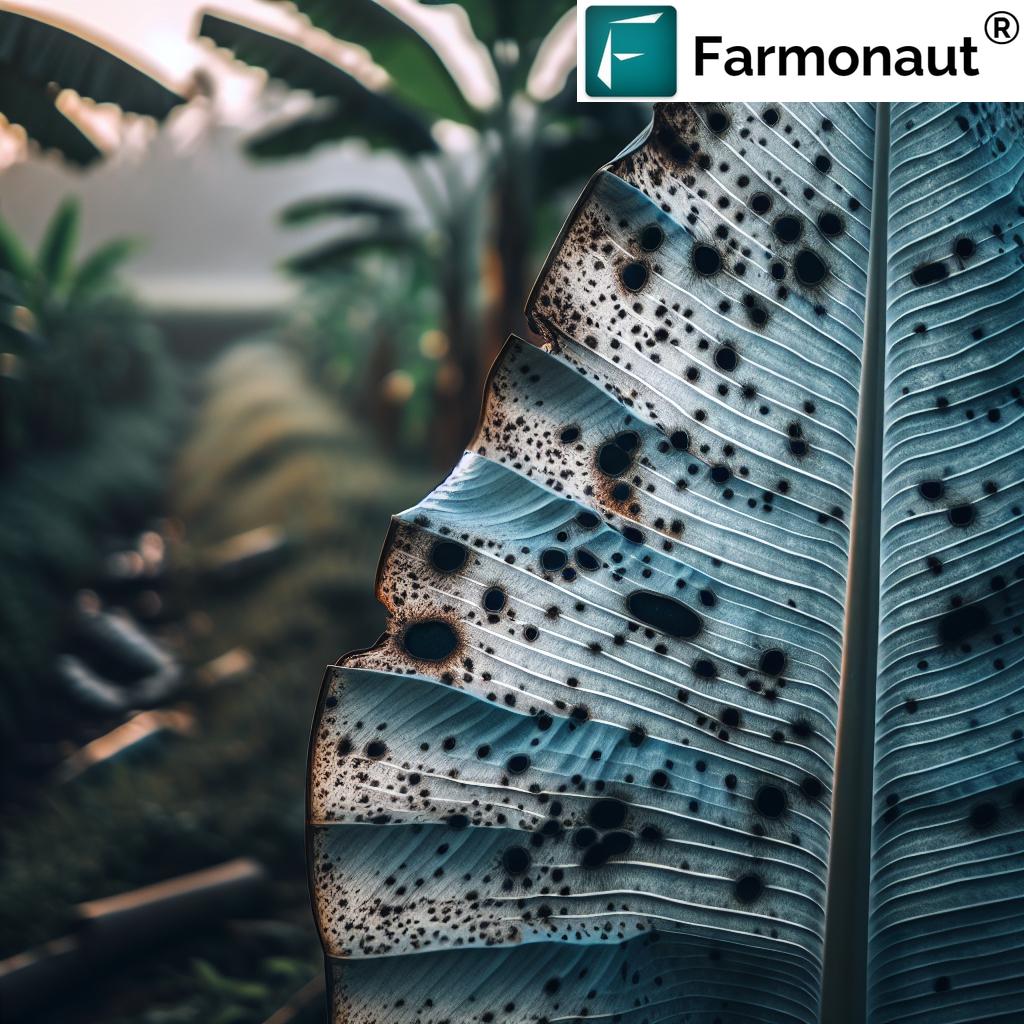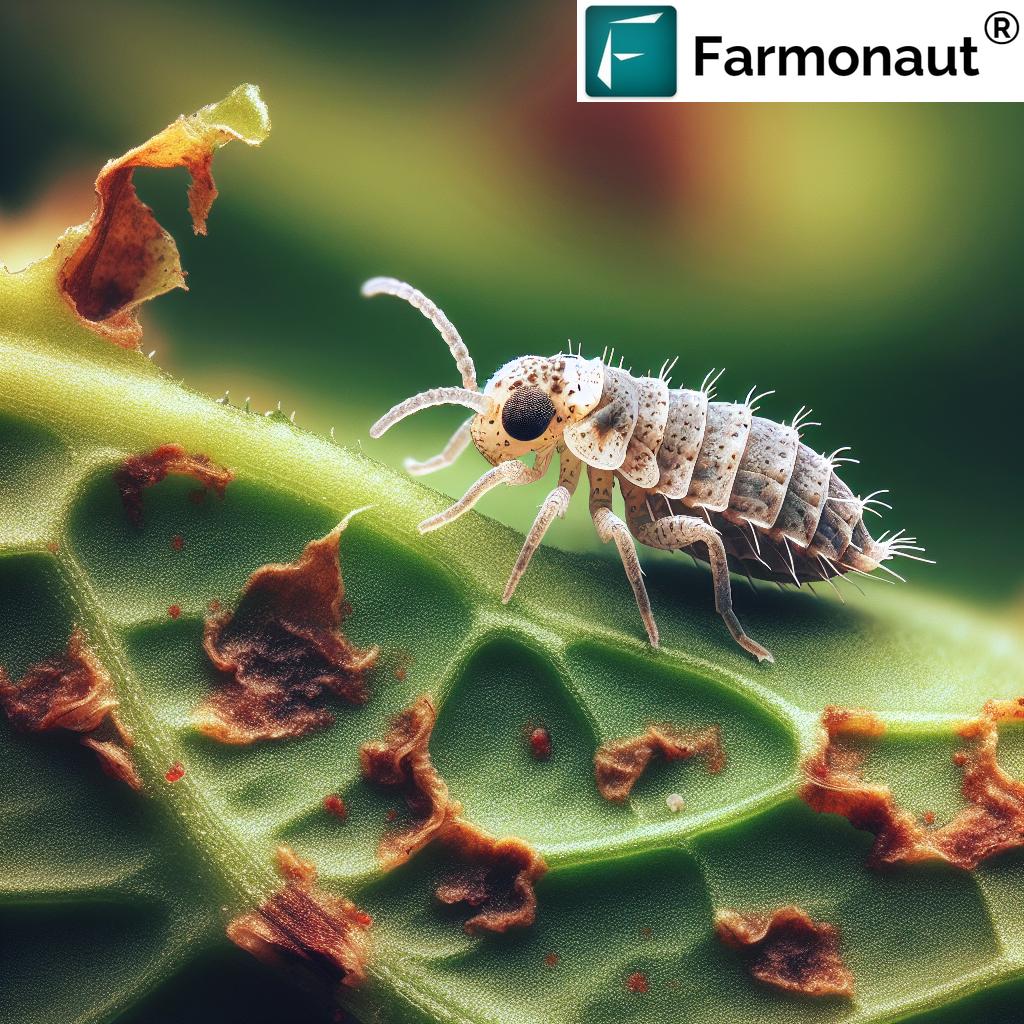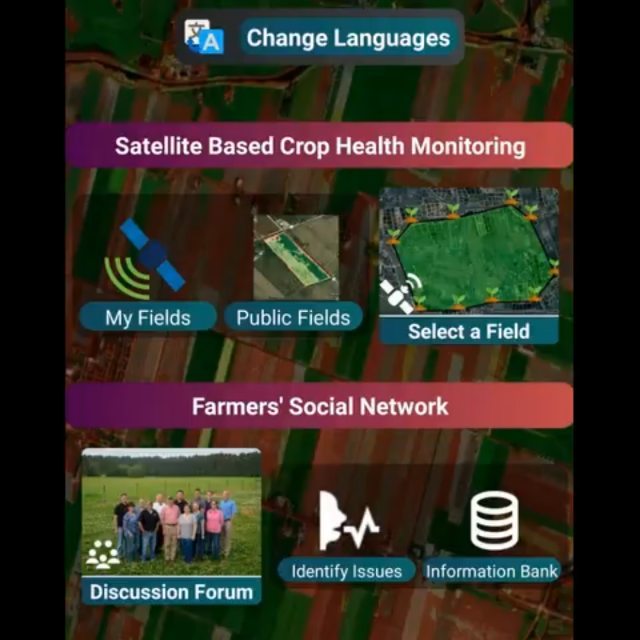
Black Sigatoka: A Comprehensive Guide to Managing this Devastating Banana Disease
In the world of banana cultivation, few threats loom as large as Black Sigatoka. This formidable fungal disease, caused by Mycosphaerella fijiensis, has become a significant concern for banana growers worldwide. At Farmonaut, we understand the critical importance of effective disease management in ensuring sustainable and productive banana crops. In this comprehensive guide, we’ll delve deep into the intricacies of Black Sigatoka, exploring its causes, symptoms, and most importantly, the diverse range of treatments available to combat this persistent pest.
Understanding Black Sigatoka: The Fungal Menace
Black Sigatoka, also known as Black Leaf Streak Disease, is a fungal infection that primarily affects banana plants. The causative agent, Mycosphaerella fijiensis, is a relentless pathogen that can devastate entire banana plantations if left unchecked. To effectively combat this disease, it’s crucial to understand its lifecycle and the conditions that favor its spread.
The Lifecycle of Mycosphaerella fijiensis
- Spore Production: The fungus produces two types of spores: ascospores and conidia.
- Dispersal: These spores are spread by wind and rain, traveling to new host plants.
- Infection: Spores germinate on banana leaves, penetrating the leaf tissue.
- Symptom Development: Initial symptoms appear as small, dark spots on the leaves.
- Disease Progression: Spots enlarge and coalesce, leading to extensive leaf damage.
Favorable Conditions for Disease Spread
- High humidity (above 80%)
- Temperatures between 20-30°C (68-86°F)
- Presence of free water on leaf surfaces
- Poor air circulation within the plantation
These conditions are often prevalent in tropical and subtropical regions where bananas are commonly grown, making Black Sigatoka a persistent threat in these areas.
Recognizing the Symptoms: Early Detection is Key
Early identification of Black Sigatoka is crucial for effective management. The disease progresses through several stages, each with distinct characteristics:
- Stage 1: Small, light-colored specks (1-2 mm) appear on the undersides of leaves.
- Stage 2: Specks elongate and turn reddish-brown.
- Stage 3: Streaks elongate further and darken.
- Stage 4: Streaks become dark brown to black and are visible on both sides of the leaf.
- Stage 5: Streaks widen and develop a yellow halo.
- Stage 6: The center of the lesion dries out and turns gray.
As the disease progresses, infected leaves may rapidly turn brown and die, significantly reducing the plant’s photosynthetic capacity and fruit yield.
The Impact of Black Sigatoka on Banana Production
The effects of Black Sigatoka on banana crops can be devastating:
- Reduced photosynthetic area leading to decreased plant vigor
- Premature ripening of fruit, reducing marketability
- Yield losses of up to 50% in severe cases
- Increased production costs due to necessary control measures
- Potential for complete crop failure in unmanaged plantations
Given these severe consequences, implementing effective control strategies is paramount for banana growers.
Integrated Management Strategies for Black Sigatoka Control
At Farmonaut, we advocate for an integrated approach to managing Black Sigatoka. This comprehensive strategy combines cultural, biological, and chemical methods to achieve optimal disease control while minimizing environmental impact.
1. Cultural Control Methods
Cultural practices play a crucial role in preventing and managing Black Sigatoka:
- Proper Plant Spacing: Ensure adequate spacing between plants to improve air circulation and reduce humidity.
- Leaf Pruning: Regular removal of infected leaves helps reduce inoculum levels.
- Field Sanitation: Remove and destroy fallen leaves and other plant debris.
- Water Management: Avoid overhead irrigation to reduce leaf wetness periods.
- Crop Rotation: Where possible, rotate with non-host crops to break the disease cycle.
2. Resistant Varieties
Planting resistant or tolerant banana varieties is an effective long-term strategy. Some resistant cultivars include:
- FHIA-01 (Goldfinger)
- FHIA-17
- FHIA-23
- Yangambi Km 5
However, it’s important to note that resistance can break down over time, and these varieties may not always meet market preferences.
3. Biological Control
While still an emerging field, biological control shows promise in managing Black Sigatoka:
- Antagonistic Microorganisms: Certain fungi and bacteria can inhibit the growth of M. fijiensis.
- Plant-Based Extracts: Some natural plant extracts have shown antifungal properties against Black Sigatoka.
Research in this area is ongoing, and we at Farmonaut are keenly following developments in biological control methods.
4. Chemical Control
Chemical fungicides remain a crucial tool in managing Black Sigatoka, especially in large-scale commercial plantations. However, their use must be carefully managed to prevent resistance development and minimize environmental impact.
Types of Fungicides Used:
- Protectant Fungicides: Applied preventively to protect uninfected tissue.
- Systemic Fungicides: Can cure early infections and provide longer-lasting protection.
Common Active Ingredients:
- Mancozeb
- Chlorothalonil
- Propiconazole
- Azoxystrobin
- Difenoconazole
It’s crucial to rotate between different fungicide classes to prevent resistance development.
Organic Approaches to Black Sigatoka Management
For organic banana growers or those looking to reduce chemical inputs, several organic methods can help manage Black Sigatoka:
1. Compost Tea Applications
Compost tea, rich in beneficial microorganisms, can help boost plant immunity and suppress fungal growth. Regular applications can reduce disease severity.
2. Mineral Oils
Food-grade mineral oils can form a protective barrier on leaf surfaces, inhibiting spore germination. These are often used in combination with other organic fungicides.
3. Copper-Based Products
Copper fungicides, while considered organic, should be used judiciously due to potential soil accumulation. They can be effective when applied preventively.
4. Plant Extracts
Certain plant extracts have shown promise in suppressing Black Sigatoka:
- Neem oil
- Garlic extract
- Citrus seed extract
These natural products can be part of an integrated organic management strategy.
The Role of Technology in Black Sigatoka Management
At Farmonaut, we leverage cutting-edge technology to enhance Black Sigatoka management strategies. Our satellite-based crop monitoring system offers several advantages:
- Early Detection: Satellite imagery can detect early signs of stress in banana plantations, potentially indicating disease presence before visible symptoms appear.
- Precision Applications: By identifying specific areas of concern, our system allows for targeted fungicide applications, reducing overall chemical use.
- Climate Monitoring: Real-time weather data helps predict conditions favorable for disease development, allowing for proactive management.
- Yield Estimation: Accurate yield predictions can help growers make informed decisions about disease management investments.
To learn more about how Farmonaut’s technology can revolutionize your banana disease management, visit our application page.

Comparing Traditional Methods with Farmonaut’s Satellite System
| Aspect | Traditional Methods | Farmonaut Satellite System |
|---|---|---|
| Early Detection | Relies on visual inspection, often detecting disease at later stages | Satellite imagery detects early stress signs, enabling proactive management |
| Monitoring Spread | Manual field surveys, time-consuming and labor-intensive | Continuous satellite monitoring provides real-time data on disease spread |
| Precision Treatment | Broad application of fungicides across entire fields | Targeted applications based on precise mapping of affected areas |
| Cost-effectiveness | Higher labor costs and potentially excessive fungicide use | Reduced labor and optimized fungicide application, leading to cost savings |
Best Practices for Fungicide Applications
When chemical control is necessary, following best practices ensures maximum efficacy and minimizes environmental impact:
- Timing: Apply fungicides preventively or at the earliest signs of infection.
- Coverage: Ensure thorough coverage of both upper and lower leaf surfaces.
- Rotation: Alternate between fungicides with different modes of action to prevent resistance.
- Weather Considerations: Apply during favorable weather conditions to maximize efficacy and minimize drift.
- Calibration: Regularly calibrate spraying equipment for accurate application rates.
- Personal Protection: Always use appropriate personal protective equipment (PPE) when handling and applying fungicides.
The Importance of Integrated Pest Management (IPM)
At Farmonaut, we strongly advocate for an Integrated Pest Management (IPM) approach to Black Sigatoka control. IPM combines various control methods to achieve effective disease management while minimizing environmental impact and promoting long-term sustainability.
Key Components of IPM for Black Sigatoka:
- Monitoring: Regular field scouting and use of early detection technologies like our satellite monitoring system.
- Cultural Practices: Implementing good agronomic practices to create unfavorable conditions for disease development.
- Biological Control: Incorporating natural enemies and beneficial microorganisms where possible.
- Chemical Control: Judicious use of fungicides based on economic thresholds and resistance management principles.
- Record Keeping: Maintaining detailed records of disease incidence, control measures, and their efficacy.
By adopting an IPM approach, banana growers can achieve more sustainable and cost-effective disease management in the long run.
The Economic Impact of Black Sigatoka and the Value of Effective Management
The economic consequences of Black Sigatoka can be severe, making effective management crucial for the sustainability of banana production:
- Yield Losses: Uncontrolled Black Sigatoka can lead to yield reductions of up to 50% or more.
- Quality Reduction: Infected fruit may ripen prematurely, reducing marketability and export potential.
- Increased Production Costs: Intensive fungicide programs can significantly increase production expenses.
- Market Access: Stringent quality standards in export markets may reject fruit from heavily infected plantations.
Investing in effective management strategies, including advanced technologies like Farmonaut’s satellite monitoring system, can provide substantial returns by protecting yield, quality, and market access.
Future Directions in Black Sigatoka Management
As we look to the future, several promising areas of research and development are likely to shape Black Sigatoka management:
- Genetic Resistance: Ongoing efforts to develop banana varieties with durable resistance to Black Sigatoka.
- Novel Biological Control Agents: Discovery and development of new microorganisms effective against M. fijiensis.
- Precision Agriculture: Further integration of technologies like AI and drone monitoring for ultra-precise disease management.
- Climate-Resilient Strategies: Developing management approaches that account for changing climate patterns and their impact on disease dynamics.
At Farmonaut, we’re committed to staying at the forefront of these developments, continually enhancing our technology to provide banana growers with the most advanced and effective tools for disease management.
Farmonaut’s Commitment to Sustainable Banana Production
Our mission at Farmonaut extends beyond providing technological solutions. We’re dedicated to promoting sustainable agriculture practices that benefit both farmers and the environment. Our approach to Black Sigatoka management is rooted in this commitment:
- Reducing Chemical Inputs: By enabling precise and targeted treatments, we help minimize unnecessary fungicide applications.
- Empowering Farmers: Our user-friendly platform provides growers with the information they need to make informed decisions.
- Promoting Biodiversity: By advocating for integrated pest management, we support practices that maintain ecological balance in banana plantations.
- Enhancing Food Security: Effective disease management contributes to stable banana production, supporting global food security efforts.
To explore how Farmonaut can support your banana production efforts, visit our API documentation or download our mobile app for Android or iOS.
Frequently Asked Questions (FAQ)
- Q: How quickly can Black Sigatoka spread in a banana plantation?
A: Black Sigatoka can spread rapidly under favorable conditions. In susceptible varieties, the disease can progress from initial infection to severe symptoms within 3-4 weeks. - Q: Can Black Sigatoka be completely eradicated from an infected plantation?
A: Complete eradication is challenging once the disease is established. The focus should be on effective management to keep infection levels low and minimize economic impact. - Q: Are organic fungicides as effective as chemical fungicides in controlling Black Sigatoka?
A: Organic fungicides can be effective, especially when used as part of an integrated management approach. However, they may require more frequent applications and careful timing compared to some chemical options. - Q: How does climate change affect the spread of Black Sigatoka?
A: Climate change can potentially increase the range and severity of Black Sigatoka by altering temperature and humidity patterns. This makes adaptive management strategies crucial. - Q: Can Farmonaut’s satellite monitoring detect Black Sigatoka before visible symptoms appear?
A: While our system can detect early signs of plant stress, which may indicate disease presence, it’s important to combine this technology with regular field scouting for the most accurate early detection.
Conclusion: A Holistic Approach to Black Sigatoka Management
Black Sigatoka remains one of the most significant challenges in banana production worldwide. However, with a comprehensive understanding of the disease and a multi-faceted management approach, it’s possible to effectively control its spread and minimize its impact. At Farmonaut, we’re committed to supporting banana growers in this endeavor by providing cutting-edge technology and data-driven insights.
By combining traditional agricultural wisdom with modern technological advancements, we can work towards more resilient, sustainable, and productive banana plantations. Remember, effective Black Sigatoka management is not just about protecting crops; it’s about securing the future of banana production and the livelihoods of millions who depend on it.
For more information on how Farmonaut can revolutionize your approach to banana disease management, explore our developer documentation or reach out to our team of experts.
Together, we can cultivate healthier bananas and a more sustainable future for agriculture.













